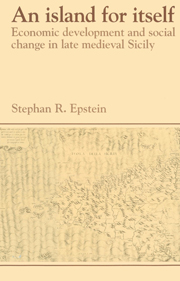Book contents
- Frontmatter
- Contents
- List of maps
- List of tables
- Acknowledgments
- Abbreviations
- Currency and measurements
- Chronology
- 1 Introduction. The historiography and the sources
- 2 Regional geographic and demographic differentiation
- 3 Market structures and regional specialization
- 4 Sicily and its regions. Economic growth and specialization
- 5 Sicily and its regions. Eastern val Demone and the southern mainland
- 6 Foreign trade and the domestic economy
- 7 Income distribution, social conflict and the Sicilian state
- 8 A further question: the origins of Sicilian underdevelopment
- Bibliography
- Index
- Past and Present Publications
6 - Foreign trade and the domestic economy
Published online by Cambridge University Press: 06 January 2010
- Frontmatter
- Contents
- List of maps
- List of tables
- Acknowledgments
- Abbreviations
- Currency and measurements
- Chronology
- 1 Introduction. The historiography and the sources
- 2 Regional geographic and demographic differentiation
- 3 Market structures and regional specialization
- 4 Sicily and its regions. Economic growth and specialization
- 5 Sicily and its regions. Eastern val Demone and the southern mainland
- 6 Foreign trade and the domestic economy
- 7 Income distribution, social conflict and the Sicilian state
- 8 A further question: the origins of Sicilian underdevelopment
- Bibliography
- Index
- Past and Present Publications
Summary
INTRODUCTION
We have seen in the previous chapters that to describe late medieval Sicily as a staple grain exporter, undeveloped but for two industries (sugar and silk) linked to foreign markets, caricatures existing conditions and misrepresents the relative importance of foreign to domestic trade. Nonetheless, while I have argued that the latter was the prime cause of structural changes at the regional level, I do not intend simply to turn arguments about ‘dependence’ on their head and take refuge in purely ‘endogenist’ explanations of economic development.
In fact, the theoretical divergences between the ‘dualist’ and the ‘endogenous’ models of economic development partly reflect the empirical distinction, which prevailed before the later Middle Ages, between long-distance trade in high-value goods, and shorter-range exchange of low-value, bulk commodities. We saw in chapters 1 and 3 that both the dualist and the ‘endogenist’ model appear to rest on the assumption of peasant subsistence or of a specific ‘peasant economy’. I also suggested that the problems this raises can be solved if one assumes instead that peasants did not avoid commercialization as a matter of principle, but pursued economic strategies shaped by imperfect information and by prevailing institutional constraints on commoditization.
- Type
- Chapter
- Information
- An Island for ItselfEconomic Development and Social Change in Late Medieval Sicily, pp. 268 - 313Publisher: Cambridge University PressPrint publication year: 1992



